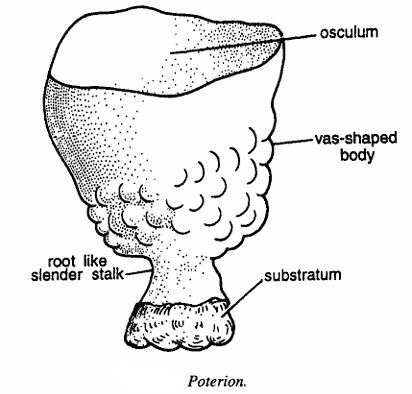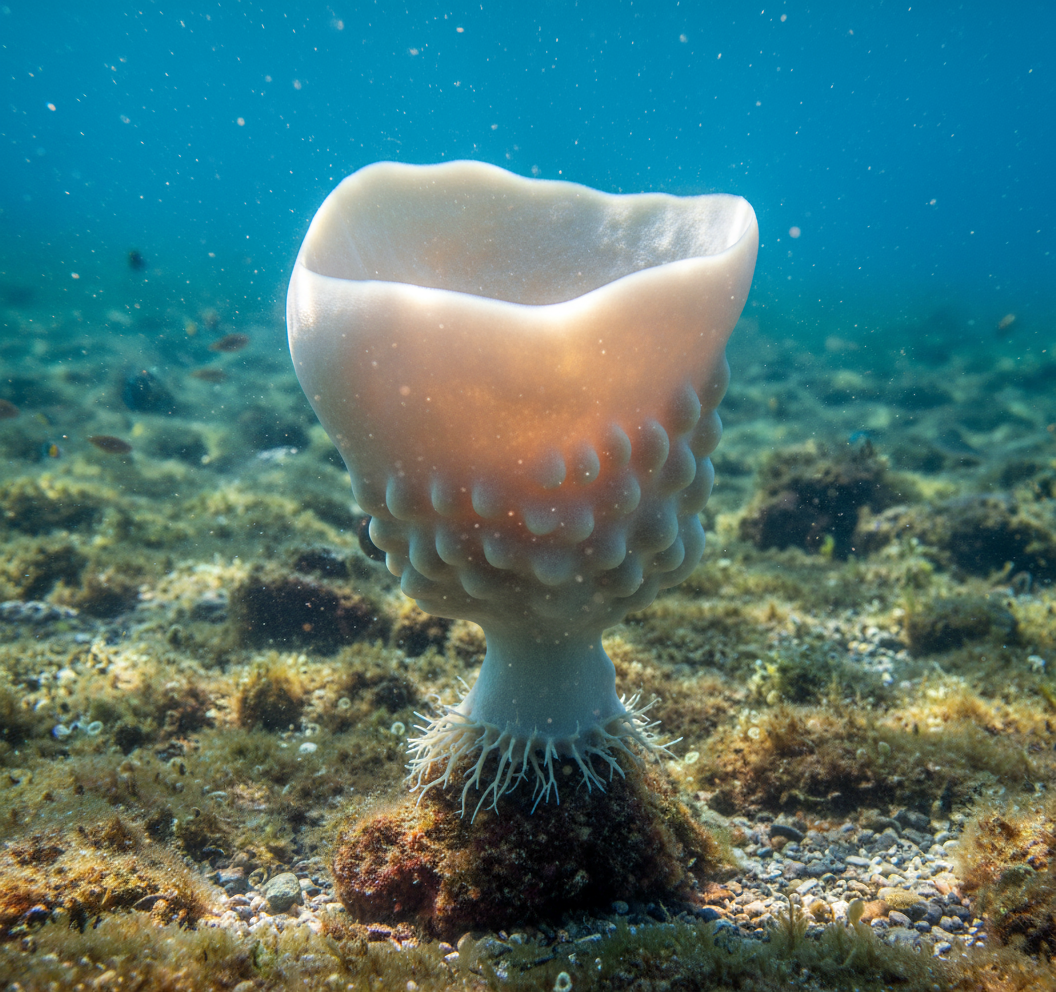Classification of Poterion
- Phylum: Porifera (Aquatic animals with porous bodies and cellular grade of organization)
- Class: Demospongiae (Sponges with skeletons composed of spongin fibers and siliceous spicules)
- Order: Poecilosclerida (Characterized by diverse shaped spicules including megascleres and microscleres)
- Family: Desmacellidae (Sponges with a skeleton primarily made of megascleres, typically including styles and strongyles)
- Genus: Poterion
Poterion is a genus of marine sponges characterized by their tubular to cylindrical shape and spicate skeleton, belonging to one of the distinct groups within the phylum Porifera. These sponges contribute to marine benthic habitats by filtering water and providing shelters for various small organisms.

Habit and Habitat
Poterion sponges usually inhabit marine environments where they firmly attach to rocks, coralline substrates, or other hard surfaces. The genus favors shallow to moderate depths in coastal areas with good water circulation. The tubular shape often helps water flow through their bodies for efficient filter feeding.
Geographical Distribution
Poterion is primarily found in temperate to tropical marine waters, including the coasts of the Indian Ocean and parts of the Indo-Pacific region. Occurrences are often associated with coral reefs and rocky underwater outcrops where suitable attachment surfaces are available.
General Characteristics
- Commonly called as Neptune’s goblet.
- It is supposed to be one of the largest sponges, which may attain a diameter or height of 1 to 2 meters.
- Body becomes free, large, vase-shaped, with incurrent apertures on the outer surface and excurrent on the inner surface.
- Skeleton comprises tylostyles. There is a large osculum at anterior end.
- Posterior end has root-like processes in the form of slender stalk attached to substratum.
- The body is tubular or cylindrical, often erect and stalked or simple in form.
- Coloration varies but is mostly pale or muted tones, allowing camouflage against substrates.
- The skeleton consists of megascleres such as styles and strongyles, arranged to support the tubular structure.
- Microscleres may be present as chelae or sigmas contributing to surface texture and defense.
- The surface is smooth to slightly roughened, with visible ostia and a terminal or subterminal osculum.
- The sponge exhibits a leuconoid canal system facilitating effective water filtration.

Special Features
A key feature of Poterion species is their robust and specialized spicule skeleton which lends structural integrity to their tubular body, allowing them to withstand moderate water currents. Their microscleres help protect from predation and contribute to the sponge’s defensive adaptations.
Identification
The specimen has large osculum, large cup-shaped body with a small stalk and all above feature, hence it is Poterion.
Poterion can be identified by its tubular shape, smooth surface, and specialized skeleton featuring megascleres and various microscleres. The presence of a singular osculum and the arrangement of spicules in the cortex and choanosome provide key traits for species identification under microscopic examination.
References:
- https://byjus.com/biology/porifera/
- https://en.wikipedia.org/wiki/Sponge
- https://www.scribd.com/document/562966886/CLASSIFICATION-OF-PORIFERA
- https://www.vedantu.com/biology/phylum-porifera
- https://bncollegebgp.ac.in/wp-content/uploads/2020/04/BSc-Zoology-Part-I-Porifera.pdf
- https://www.biologydiscussion.com/invertebrate-zoology/phylum-porifera/3-main-classes-of-phylum-porifera/32574
- https://study.com/academy/lesson/phylum-porifera-definition-characteristics-examples.html
- https://manoa.hawaii.edu/exploringourfluidearth/biological/invertebrates/phylum-porifera
- https://vlearnias.in/phylum-porifera/
- https://www.scribd.com/document/757540354/General-Characteristics-and-Classification-of-Porifera-Final

